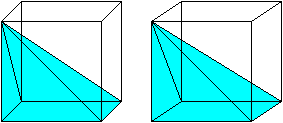Consider a cylindrical container of negligible thickness with radius $r$ and height $h$, placed sideways containing some liquid (with volume $V$) inside as shown below.
Define a function $f(r,h,V) = A/V.$
where $A$ = Area of the container that is in contact with the liquid given $V > 0$ and $V \leq πhr^2.$
Is there a way to express this function only in terms of $r,R,h$ and $V$?
I know how to calculate the ratio of $Ah/V$ when the liquid is half the volume of the cylinder but not when it is not. I believe it involves using integral but I don't know how to set it up.
The objective is to have a formula where I can plug in numerical values of $(r,h,V) $ such that I get the ratio of $Ah/V.$
Any help would be greatly appreciated. Thank you.



Best Answer
To solve your problem, I think it's useful to break your problem into easier, smaller problems.
How? Your problem could be summed up as trying to determine the area of the shaded areas of these two figures (Why?):
Let's tackle them separately.
Shaded area of the circle
I claim that $V = Sh$, where $S$ is the area of the shaded region on the circle. Can you see why?
If so, how can we deduce the value of $S$?
Shaded area of the rectangle
The area of the rectangle is $A = ab$, where $a$ is the height and $b$ is the width. We do have the height, which is $h$. The width is an arc of the circumference.
Think about how you would determine the length of the arc of circumference if you only had the point $p=(x, y)$, which is shown in the first figure (this point is unknown, but we'll get into it later on).
Hint → Try to express the points of the circumference in terms of an angle.
Spoiler
With this, can you determine the length of the arc?
Spoiler
Now, how can you determine the point $(x, y)$?
Hint → Try to divide the shaded area $S$ into infinitesimal horizontal slices.
Spoiler
Knowing this, can you describe an integral that equals this area?
Hint → Try to define an integral in the interval $[\pi-\alpha, 3/2\pi]$, the one that starts in the left side until the bottom.
Spoiler
With this, determine the value of $\alpha$, and thus, get the length of the arc of circumference, which is the missing piece to determine the value of the shaded area of the rectangle.
P.S.: I might have some typos or not clearly written phrases, don't hesitate to highlight them for further correction!